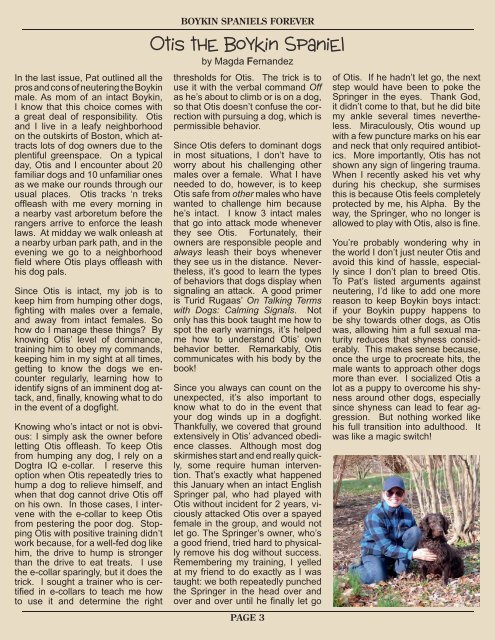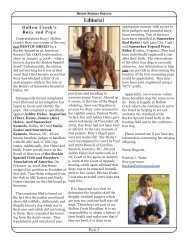Create successful ePaper yourself
Turn your PDF publications into a flip-book with our unique Google optimized e-Paper software.
In the last issue, Pat outlined all the<br />
pros and cons of neutering the Boykin<br />
male. As mom of an intact Boykin,<br />
I know that this choice comes with<br />
a great deal of responsibility. Otis<br />
and I live in a leafy neighborhood<br />
on the outskirts of Boston, which attracts<br />
lots of dog owners due to the<br />
plentiful greenspace. On a typical<br />
day, Otis and I encounter about 20<br />
familiar dogs and 10 unfamiliar ones<br />
as we make our rounds through our<br />
usual places. Otis tracks ‘n treks<br />
offleash with me every morning in<br />
a nearby vast arboretum before the<br />
rangers arrive to enforce the leash<br />
laws. At midday we walk onleash at<br />
a nearby urban park path, and in the<br />
evening we go to a neighborhood<br />
field where Otis plays offleash with<br />
his dog pals.<br />
Since Otis is intact, my job is to<br />
keep him from humping other dogs,<br />
fighting with males over a female,<br />
and away from intact females. So<br />
how do I manage these things By<br />
knowing Otis’ level of dominance,<br />
training him to obey my commands,<br />
keeping him in my sight at all times,<br />
getting to know the dogs we encounter<br />
regularly, learning how to<br />
identify signs of an imminent dog attack,<br />
and, finally, knowing what to do<br />
in the event of a dogfight.<br />
Knowing who’s intact or not is obvious:<br />
I simply ask the owner before<br />
letting Otis offleash. To keep Otis<br />
from humping any dog, I rely on a<br />
Dogtra IQ e-collar. I reserve this<br />
option when Otis repeatedly tries to<br />
hump a dog to relieve himself, and<br />
when that dog cannot drive Otis off<br />
on his own. In those cases, I intervene<br />
with the e-collar to keep Otis<br />
from pestering the poor dog. Stopping<br />
Otis with positive training didn’t<br />
work because, for a well-fed dog like<br />
him, the drive to hump is stronger<br />
than the drive to eat treats. I use<br />
the e-collar sparingly, but it does the<br />
trick. I sought a trainer who is certified<br />
in e-collars to teach me how<br />
to use it and determine the right<br />
BOYKIN SPANIELS FOREVER<br />
Otis the Boykin Spaniel<br />
by Magda Fernandez<br />
thresholds for Otis. The trick is to<br />
use it with the verbal command Off<br />
as he’s about to climb or is on a dog,<br />
so that Otis doesn’t confuse the correction<br />
with pursuing a dog, which is<br />
permissible behavior.<br />
Since Otis defers to dominant dogs<br />
in most situations, I don’t have to<br />
worry about his challenging other<br />
males over a female. What I have<br />
needed to do, however, is to keep<br />
Otis safe from other males who have<br />
wanted to challenge him because<br />
he’s intact. I know 3 intact males<br />
that go into attack mode whenever<br />
they see Otis. Fortunately, their<br />
owners are responsible people and<br />
always leash their boys whenever<br />
they see us in the distance. Nevertheless,<br />
it’s good to learn the types<br />
of behaviors that dogs display when<br />
signaling an attack. A good primer<br />
is Turid Rugaas’ On Talking Terms<br />
with Dogs: Calming Signals. Not<br />
only has this book taught me how to<br />
spot the early warnings, it’s helped<br />
me how to understand Otis’ own<br />
behavior better. Remarkably, Otis<br />
communicates with his body by the<br />
book!<br />
Since you always can count on the<br />
unexpected, it’s also important to<br />
know what to do in the event that<br />
your dog winds up in a dogfight.<br />
Thankfully, we covered that ground<br />
extensively in Otis’ advanced obedience<br />
classes. Although most dog<br />
skirmishes start and end really quickly,<br />
some require human intervention.<br />
That’s exactly what happened<br />
this January when an intact English<br />
Springer pal, who had played with<br />
Otis without incident for 2 years, viciously<br />
attacked Otis over a spayed<br />
female in the group, and would not<br />
let go. The Springer’s owner, who’s<br />
a good friend, tried hard to physically<br />
remove his dog without success.<br />
Remembering my training, I yelled<br />
at my friend to do exactly as I was<br />
taught: we both repeatedly punched<br />
the Springer in the head over and<br />
over and over until he finally let go<br />
PAGE 3<br />
of Otis. If he hadn’t let go, the next<br />
step would have been to poke the<br />
Springer in the eyes. Thank God,<br />
it didn’t come to that, but he did bite<br />
my ankle several times nevertheless.<br />
Miraculously, Otis wound up<br />
with a few puncture marks on his ear<br />
and neck that only required antibiotics.<br />
More importantly, Otis has not<br />
shown any sign of lingering trauma.<br />
When I recently asked his vet why<br />
during his checkup, she surmises<br />
this is because Otis feels completely<br />
protected by me, his Alpha. By the<br />
way, the Springer, who no longer is<br />
allowed to play with Otis, also is fine.<br />
You’re probably wondering why in<br />
the world I don’t just neuter Otis and<br />
avoid this kind of hassle, especially<br />
since I don’t plan to breed Otis.<br />
To Pat’s listed arguments against<br />
neutering, I’d like to add one more<br />
reason to keep Boykin boys intact:<br />
if your Boykin puppy happens to<br />
be shy towards other dogs, as Otis<br />
was, allowing him a full sexual maturity<br />
reduces that shyness considerably.<br />
This makes sense because,<br />
once the urge to procreate hits, the<br />
male wants to approach other dogs<br />
more than ever. I socialized Otis a<br />
lot as a puppy to overcome his shyness<br />
around other dogs, especially<br />
since shyness can lead to fear aggression.<br />
But nothing worked like<br />
his full transition into adulthood. It<br />
was like a magic switch!








